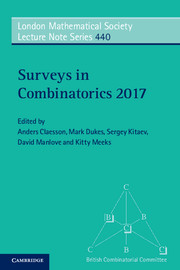Book contents
- Frontmatter
- Contents
- Preface
- 1 Relations among partitions
- 2 Large-scale structures in random graphs
- 3 The spt-function of Andrews
- 4 Combinatorial structures in finite classical polar spaces
- 5 Switching techniques for edge decompositions of graphs
- 6 Ramsey-type and amalgamation-type properties of permutations
- 7 Monotone cellular automata
- 8 Robustness of graph properties
- 9 Some applications of relative entropy in additive combinatorics
- References
6 - Ramsey-type and amalgamation-type properties of permutations
Published online by Cambridge University Press: 21 July 2017
- Frontmatter
- Contents
- Preface
- 1 Relations among partitions
- 2 Large-scale structures in random graphs
- 3 The spt-function of Andrews
- 4 Combinatorial structures in finite classical polar spaces
- 5 Switching techniques for edge decompositions of graphs
- 6 Ramsey-type and amalgamation-type properties of permutations
- 7 Monotone cellular automata
- 8 Robustness of graph properties
- 9 Some applications of relative entropy in additive combinatorics
- References
Summary
Abstract
This survey deals with some aspects of combinatorics of permutations which are inspired by notions from structural Ramsey theory. Its first main focus is the overview of known results on Ramsey-type and Fraïssé-type properties of hereditary permutation classes, with particular emphasis on the concept of splittability. Secondly, we look at known estimates for Ramsey numbers of permutation matrices, and their relationship to Ramsey numbers of ordered graphs.
Introduction
About this survey
Combinatorics of permutations is an old and well-established field of discrete mathematics. So is Ramsey theory. For a long time these two fields have followed their own separate ways without affecting each other much. However, in the first decade of this century, the situation started to slowly change, as concepts originating from the research on relational structures and on Ramsey classes became adopted (or, occasionally, reinvented) in the study of hereditary permutation classes.
The purpose of this paper is to give an introductory overview of the Ramsey-theoretic and relation-theoretic aspects of combinatorics of permutations, with particular focus on hereditary permutation classes. I do not assume any familiarity with either structural Ramsey theory or permutation combinatorics. In the rest of this first chapter, the reader will find a condensed introduction to the relevant notions from these fields.
Chapter 2 will then present a survey of the known results related to amalgamation, Ramseyness and other related properties of hereditary permutation classes.
The remaining two chapters contain a more detailed treatment of two specific topics related to amalgamation and Ramsey properties of permutations.
Chapter 3 focuses on the notion of unsplittability, a weak form of Ramsey property that has recently found applications in enumerative combinatorics of permutations, and appears to be a promising research direction.
Consequently, splittability and unsplittability play a prominent role in this survey; indeed, Chapter 3 is the longest of the four chapters.
Chapter 4 deals with estimates on Ramsey numbers of permutations. This topic, which is closely connected to graph theory, has received interest only very recently, with only a few nontrivial results known, and many basic questions still open.
Information
- Type
- Chapter
- Information
- Surveys in Combinatorics 2017 , pp. 272 - 311Publisher: Cambridge University PressPrint publication year: 2017
